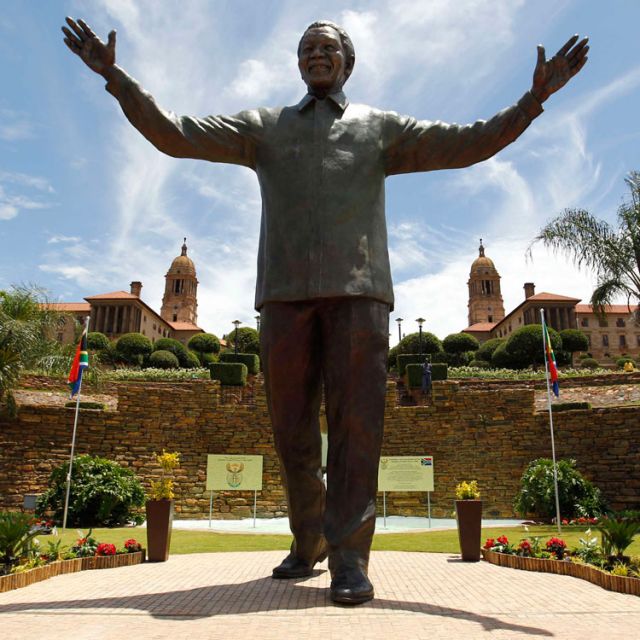"There was a feeling of being blessed among the thousands" who gathered Dec. 16 outside the Union Buildings, the government headquarters, to see the nine-meter bronze statue, Father Mkhatshwa said in a telephone interview.
The statue was unveiled on South Africa's Day of Reconciliation, a public holiday, which is "extraordinary and wonderful timing," he said.
Instead of being portrayed with the clenched fist of the revolutionary, Mandela is shown with outstretched hands, "as if to say, 'let us embrace each other, we are all one family,'" said Father Mkhatshwa, a former mayor of Tshwane, a metropolitan municipality that includes Pretoria.
Mandela, anti-apartheid leader and former South African president, died Dec. 5 at the age of 95. His body lay in state at the Union Buildings for three days before being taken to his ancestral home in the rural village of Qunu for the Dec. 15 state funeral.
More than 4,000 people -- including several heads of state, former U.S. President Bill Clinton, the Rev. Jesse Jackson, entrepreneur Richard Branson and Oprah Winfrey -- attended the funeral that was held in a specially erected marquee.
Mandela's coffin was taken on a gun carriage from his house to the white-domed marquee, where his portrait stood behind 95 candles, one for each year of his life.
Outside the marquee, Xhosa men in traditional dress, replete with shields and spears, danced their culture's send-off.
After the service, the casket was carried by the military up a hill to the graveside. South Africa's air force staged a flyby as the coffin was lowered into the grave.
Archbishop Stephen Brislin of Cape Town, president of the Southern African Catholic Bishops' Conference, was among religious leaders at the graveside.
In a tweet after the funeral, Archbishop Brislin used Mandela's clan name: "May Madiba rest in peace. May his family and all those who mourn him be given consolation and comfort."
In a radio interview, Branson said retired Anglican Archbishop Desmond Tutu told mourners at the graveside that, to be remembered, Mandela "doesn't need a stone, he is in all of our hearts."
Methodist Bishop Ziphozihle Siwa, the church's presiding bishop in South Africa, said in his sermon at the funeral that the best tribute people can pay Mandela "is to strive that our lives become both recipients and transmitters of light, of hope and vibrations of life to others."
Anti-apartheid stalwart Ahmed Kathrada, 84, paid tribute to his friend he had met 67 years ago, when Mandela was tall, healthy and strong -- "the boxer, the prisoner who easily wielded the pick and shovel when the rest of us couldn't do so, the prisoner who vigorously exercised every morning."
Kathrada said that, in the hospital, the frail Mandela "held my hand, and it was profoundly heartbreaking, and it brought out all the emotions in me."
Noting that Mandela was "helpless and reduced to a shadow of himself," Kathrada said he wished he had "never had to confront" what he saw in the hospital.
Mandela, Kathrada, Andrew Mlangeni, a Catholic who addressed the Dec. 10 memorial service for Mandela in Johannesburg, and five co-accused spent many years in prison together after being sentenced to life imprisonment in 1964 for anti-apartheid activities.
Listening to the tributes at the funeral were Graca Machel, Mandela's widow, and his second wife, Winnie-Madikizela Mandela, who sat on either side of South African President Jacob Zuma.
Malawi's President Joyce Banda praised both women for their love and tolerance.
The burial marked the end of a week of Mandela memorial events that drew thousands of South Africans and world leaders.
"We'll really miss him," Father Mkhatshwa said, noting that although Mandela had not been politically active for many years, "knowing he was around was a source of strength to many of us."
The Pretoria statue is a "source of inspiration and hope" and "will help us carry forward his dream of building and defending a society that is nonracial, peaceful, people-orientated and based on freedom," he said.

